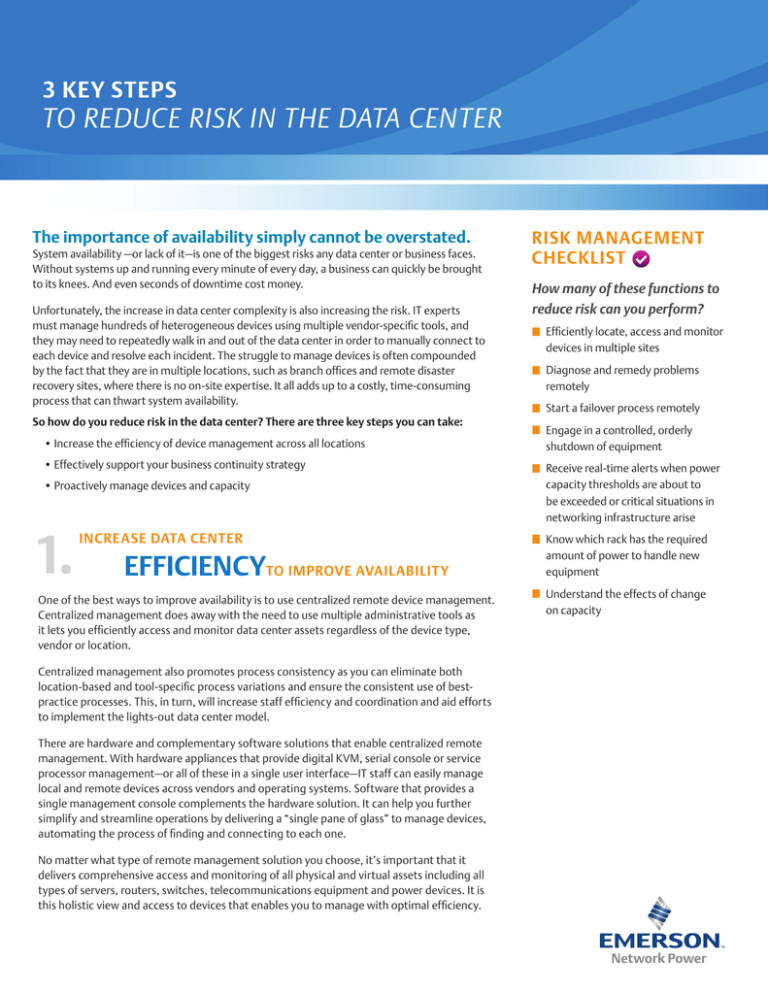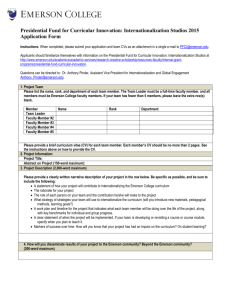
3 KEY STEPS
TO REDUCE RISK IN THE DATA CENTER
The importance of availability simply cannot be overstated.
System availability —or lack of it—is one of the biggest risks any data center or business faces.
Without systems up and running every minute of every day, a business can quickly be brought
to its knees. And even seconds of downtime cost money.
Unfortunately, the increase in data center complexity is also increasing the risk. IT experts
must manage hundreds of heterogeneous devices using multiple vendor-specific tools, and
they may need to repeatedly walk in and out of the data center in order to manually connect to
each device and resolve each incident. The struggle to manage devices is often compounded
by the fact that they are in multiple locations, such as branch offices and remote disaster
recovery sites, where there is no on-site expertise. It all adds up to a costly, time-consuming
process that can thwart system availability.
So how do you reduce risk in the data center? There are three key steps you can take:
• Increase the efficiency of device management across all locations
• Effectively support your business continuity strategy
• Proactively manage devices and capacity
1. EFFICIENCY
INCREASE DATA CENTER
TO IMPROVE AVAILABILITY
One of the best ways to improve availability is to use centralized remote device management.
Centralized management does away with the need to use multiple administrative tools as
it lets you efficiently access and monitor data center assets regardless of the device type,
vendor or location.
Centralized management also promotes process consistency as you can eliminate both
location-based and tool-specific process variations and ensure the consistent use of bestpractice processes. This, in turn, will increase staff efficiency and coordination and aid efforts
to implement the lights-out data center model.
There are hardware and complementary software solutions that enable centralized remote
management. With hardware appliances that provide digital KVM, serial console or service
processor management—or all of these in a single user interface—IT staff can easily manage
local and remote devices across vendors and operating systems. Software that provides a
single management console complements the hardware solution. It can help you further
simplify and streamline operations by delivering a “single pane of glass” to manage devices,
automating the process of finding and connecting to each one.
No matter what type of remote management solution you choose, it’s important that it
delivers comprehensive access and monitoring of all physical and virtual assets including all
types of servers, routers, switches, telecommunications equipment and power devices. It is
this holistic view and access to devices that enables you to manage with optimal efficiency.
RISK MANAGEMENT
CHECKLIST
How many of these functions to
reduce risk can you perform?
Efficiently locate, access and monitor
devices in multiple sites
Diagnose and remedy problems
remotely
Start a failover process remotely
Engage in a controlled, orderly
shutdown of equipment
Receive real-time alerts when power
capacity thresholds are about to
be exceeded or critical situations in
networking infrastructure arise
Know which rack has the required
amount of power to handle new
equipment
Understand the effects of change
on capacity
3 KEY STEPS
TO REDUCE RISK IN THE DATA CENTER
2.
REDUCE RISK BY ENSURING
BUSINESS CONTINUITY
When it comes to reducing risk, availability and business continuity
go hand in hand. IT organizations seek to reduce risk with business
continuity strategies that strive to enable the fastest recovery
possible when there are disruptions.
When it comes to disaster recovery, the ability to access devices
remotely is crucial. Typically, a disaster recovery site is located
miles away from the main data center and the experts needed
to initiate recovery. When a failover is required, it can take far
too much time to move people to the recovery site. With remote
access, physically moving people is not necessary: Your staff can
start and drive the failover remotely, quickly and easily finding,
accessing and managing assets for faster recovery and shorter
mean-time-to-repair (MTTR).
Equally important is the ability to support an orderly shutdown so
as to minimize damage to equipment in an emergency. Using tools
that allow you to define the assets that must be powered off and
the order for turning them off, you can avoid damage that could
lead to even longer business disruption.
3.
MANAGE
PROACTIVELY
YOUR DEVICES AND CAPACITY
Undoubtedly, the best way to increase availability and ensure
business continuity is to avoid problems in the first place. With the
ability to proactively monitor data about device operating status
and resource consumption, you can quickly recognize potential
power overloads before they happen.
This requires advanced tools that continuously monitor devices
down to the node level as they can automatically send updates
about the real-time power status of any device as well as issue alerts
when user-defined thresholds by zone, rack, PDU, outlet or node are
near or problems are detected.
You can also use actual power consumption data to make better
decisions about the effects of adding, changing, moving or
decommissioning devices. Centralized management can provide
comprehensive reporting that lets you compare historical power
consumption data with the available capacity of a rack. This
promotes real-world capacity management, helping you avoid
making changes that jeopardize capacity limits or result in overprovisioning that wastes resources.
Efficient device management. Effective business continuity.
Proactive capacity management. By implementing solutions that
support these three key objectives, you can improve availability,
reduce risk and consistently deliver the level of service your
business demands. Emerson Network Power works closely with
its customers and partners to deliver revolutionary solutions that
help to cut risk, increase availability, enhance operational efficiency
and achieve new levels of agility to support business growth and
transformation.
Emerson Network Power provides secure remote management
of enterprise network and data center assets regardless of their
location, state of health or brand. From data center to control
room to desktops, trust Emerson’s world class solutions to reduce
risk, establish security and business continuity, protect against
Intellectual Property theft and decrease downtime across the
entire enterprise.
Emerson Network Power
EmersonNetworkPower.com
Emerson, Emerson Network Power and the Emerson Network Power logo are trademarks and service marks of Emerson Electric Co. ©2014 Emerson Electric Co. All rights reserved.
0714-3STEPS-REDUCE-RISK-OP-EN








